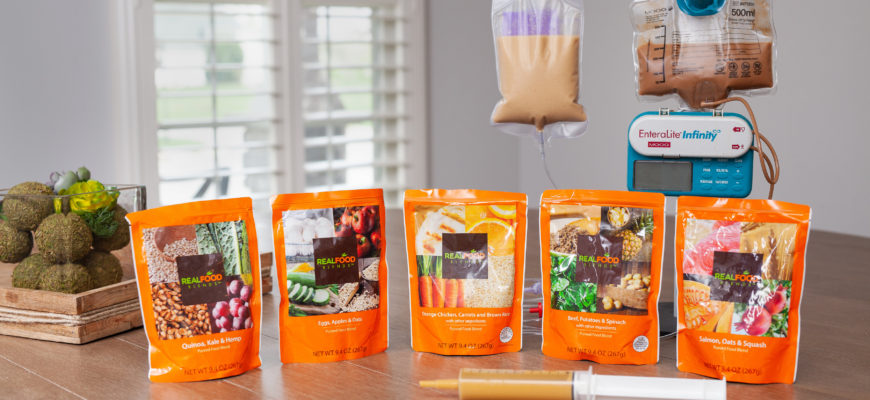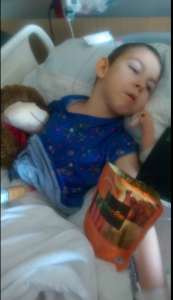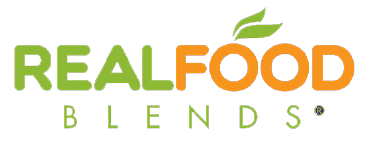
The following is a guest blog post from Weronika Brill RN.
Hospital visits can become a large part of a special needs child’s life. Between surgeries, procedures and pneumonias, spending time in the hospital can be stressful on the whole family. But having a child that “eats” a blenderized diet (BD) through a tube can leave a family unsure as to what their options are.
As a registered nurse that has worked in hospitals almost my entire career, I know that you have a lot of options and that you can be prepared for any hospital stay.
Hospital policy
If there is a regular hospital that you bring your child to make sure to call them to find out if they have a policy in place about blended food. Ask to speak with a patient advocate or a member of the dietary staff.

Tammy shared: “The picture turned out a bit blurry, but I do have to say that Real Food Blends were a lifesaver this past month when my son was in the hospital after having hip surgery.”
It will be good for you to know ahead of time because you can a) choose to go to a different hospital if they have a policy against it or b) if they do not have a policy against it you will have that knowledge in case a staff member tells you that you can’t give your child a home blend.
If policy does not allow home blends, make sure to ask if they will allow Real Food Blends. Even if they have a policy against blended food from home they should allow Real Food Blends because it is shelf stable and “controlled.” Many hospitals are even carrying Real Food Blends, so make sure you find out ahead of time to reduce stress. (Real Food Blends are available through Independence Medical, McKesson or Medline – most hospitals receive daily deliveries of supplies from one of these major distributors.)
Your last option, if they won’t allow blended diets, is asking for a fine puree meal to be sent up that you can mix with milk, water or broth and give through the tube without blending. You can have a meal sent up in almost any way as long as the doctor orders it.
Have the doctor on your side
If you are planning for a surgery, or even if you have an emergency, it is always good to have a calm conversation with the doctor who will be in charge of your child’s care. If there is a planned surgery it is good to speak with the surgeon at his/her clinic before the surgery and also at the time of the check in. If you’re in the emergency department, you can speak with the admitting physician. If the doctor agrees with you, and decides to order your home blend or Real Food Blends, then you are in a great place.
What orders to ask for?
The following are options for orders from the doctor regarding diets. The doctor may not word it exactly like this, but he will understand your request. Note: all puree diets from the hospital will be ordered as pediatric and should be balanced nutritionally.
- For clear fluids: “Clear fluids as per broth and juice from home. Clear fluids to be given through G-tube.” Or “Clear fluids tray (from hospital), clear fluids to be given per G-tube.” Or the doctor may order more specifically “Clear fluid tray 4 meals/day.” In some hospitals the dietary staff may ask for the specifics later.
- For Real Food Blends: If you will bring in your own, “Real Food Blends through G-tube as per home feeding schedule.” If the hospital carries Real Food Blends make sure the doctor or dietary staff knows how many meals or calories a day your child eats.
- For home blend: “Home blend diet through g-tube as per home feeding schedule. Parents will bring in blend.” Or “Home formula through G-tube as per home feeding schedule. Parents will bring in blend.”
- For using hospital puree food: “Fine puree pediatric diet tray (from hospital). Parents or nurses may mix with broth, milk or water and give through the G-tube as per home meal schedule.”
Handling staff members that disagree with your BD
We all know that most nurses and dietitians are supportive and great people, but every one of us has been in a situation where a staff member tells you that you can’t continue what you are doing because it’s against policy or some other reason.
First, you should already be aware of the hospital policy and remind them of it. Also, make them aware of the orders that you already have from the doctor.
If you have any further issues with that employee, do not argue or get upset, just ask to speak with the doctor or resident that is on call. Being a nurse I know we are there to not only ensure the safety of our patients but also to carry out the doctor’s orders and nursing care plan. We are not there to disagree with an order just because we don’t agree with it or feel it is wrong. Once you have a doctor in the room, calmly explain the situation and the orders the attending doctor ordered for you. If you kindly state that there is a miscommunication between the staff member and those orders, things should be cleared up rather quickly.
My biggest piece of advice about communication between you and the staff is that you will get a lot further if you keep a calm demeanor and not argue with anyone.
The diets
- Clear fluid (clear liquid) Many doctors will order clear fluids after surgery or a procedure. Things like bone broth, pedialyte and clear juice are all considered clear fluids. Your doctor may want your child to have pedialyte, but I always give my son home made bone broth instead (being on a ketogenic diet he can’t have the dextrose in the pedialyte). Homemade bone broth has electrolytes and minerals and can sustain a person for a while. My son was on clear homemade bone broth for three days in hospital and all of his electrolytes were normal during that time. If your hospital allows it, you can bring clear bone broth from home in a thermos. My recipe for bone broth is here (Real Food Blends broth recipe is here):
You can also have the hospital send up clear chicken or beef broth. I would recommend the low sodium option unless the doctor wants the regular sodium option.
- Full fluid (full liquid) A full fluid diet is a kind of step between the clear fluids and a regular diet. I’ve seen it ordered a lot for bowel surgeries, as the transition to a regular diet is slower. Things that fall into this diet are milk, milk shakes, custards, puddings, fruit juices, nectars, cream of wheat, cream of rice, ice creams and any clear fluids. You can ask your nurse or dietitian for a full list of approved full fluids for your child. With full fluids they may not need to be blended so it could be easier to have the hospital send up the fluids. You may have to add water or other fluids to make it less thick but you should be able to push all of it pretty easily.
- Regular diet A regular diet is just the diet that your child “eats” at home. It can be a low fat/high carb diet or even a ketogenic diet but it’s still your child’s regular diet. Once this diet is ordered you can use your Real Food Blend packages or any blends that you bring from home. Another option is asking for a regular meal sent up as a fine puree. You can just mix the puree with broth, milk or water and push it down the g-tube. Some hospitals will not allow this, as they may not be able to blend it as fine as needed for a BD.
Have a plan
After spending most of 2014 in and out of hospitals my husband and I now have a plan in place. We have to have our own blends because of the ketogenic diet and it’s many restrictions.
- Thermoses: We have about five high quality thermoses that we use every time we have a hospital stay. They are great for keeping things cool but even better at keeping them hot.
- Frozen clear broth: I have a freezer full of frozen broth in 8oz portions. I freeze them in ziplock bags and then put them into a pot (without the ziplock bag), frozen, and slowly bring to a boil. This allows me to quickly grab the correct amount out of my freezer. Because my son doesn’t get as full from the clear bone broth he wants to eat more often so I’ll keep 5-6 portions in my thermos for a day.
- Frozen soup blend: Whenever my son is in the hospital he has an extra sensitive stomach and I don’t give him blends with avocado or anything thick. I give him a blend of homemade bone broth, chicken and some carrot and find that he tolerates soup very well and it soothes him.
- Real Food Blends: Keep Real Food Blends around for your hospital stays or longs days going to procedures and doctor visits. They are also great to have if the power goes out, or if you’re unable to get home in time to feed your child. Many of my clients use Real Food Blends for their child’s lunch at school and for vacations.
- Preparation: When my son is in the hospital, either my husband or I will warm up one day’s worth of soup blend and keep it in the thermos for the entire day. Whoever stays at home for the night is responsible for preparing the next day’s meals. If there isn’t any soup made I will wake up early and start the soup, allow it to boil for two hours, blend a days worth of soup and store the rest in the fridge.
Hospital sign
You can make a hospital sign and place it above your child’s hospital bed to notify staff. Here is the one I made for my son:
If you would like more help please visit my Facebook group Blenderized RN.








